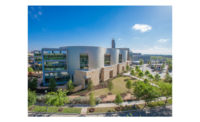
After 20 years of green initiatives, the Toledo Museum of Art in Ohio has seen energy savings of hundreds of thousands of dollars and can now boast that its 101-year-old Beaux Arts building recently went off the grid—in a temperate climate.
 |
| Toledo Museum of Art Flickering LED lights are more energy efficient and offer high quality lighting in the museums art galleries. |
Carol Bintz, the building’s chief operating officer, said the projects started slow, with the museum replacing old boilers, chillers, and engine drives with “the most efficient products available on the market at that time,” back in 1992. The museum has since installed micro-turbines in the museum’s small-scale power plant and working glass shop. The six 65 kW turbines burn natural gas, producing electricity used onsite while using waste heat to heat water in the museum’s boilers through cogeneration. Hot air from the glass-blowing furnaces also gets re-circulated through the building during the winter. “The micro-turbines made a huge difference,” Bintz said, adding that they generate 15 percent of the museum’s electrical power and have a relatively short return on investment—four years.
The museum continued to look for upgrades that were sensitive to the building’s use as a public museum. LEDs are just now being introduced into the galleries because years of technological developments have proven them both aesthetically acceptable and safe for valuable artwork. “Besides using 10 to 20 percent of the electricity [of original lamps],” Bintz said, “they are not quite as hot, and they reduce UV exposure.”
The most recent upgrade is a solar canopy system over the museum parking lot that supplements the 2,850 panels installed on the museum’s roof. The new canopy is rated for 360 kW, which, combined with the 200 kW rooftop system, enables half of the building’s energy needs to be met by photovoltaics. State and federal grants from the Ohio Department of Development’s Office of Energy Efficiency and the American Recovery and Reinvestment Act helped the museum purchase the panels, and Solscient Energy provided a power purchase agreement allowing the museum to recoup funds by selling any surplus energy back to the grid.
Bintz said the museum was willing to make the investments because “we are not going away. We have a 101-year-old building, and we will be around for hundreds more.” The museum’s educational mission also helped: “Part of it was to be a social example—to set ourselves up as an example for a building that is this old,” she said.
In 20 years, the museum has gone from purchasing an average 700,000 kWh a month to 117,000 kWh, offsetting its reliance on the grid through its own energy production. And for a short time in May 2013, the museum started returning energy back. Reflecting on the achievement, Bintz said, “When you are open to the public—doors are open, lights are on—it is very exciting not to be drawing from the grid.”
Copyright 2013 by BuildingGreen Inc.


Post a comment to this article
Report Abusive Comment